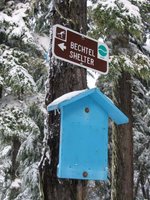
At the Gold Lake Sno-Park, one mile west of Willamette Pass, is a parking area to begin cross country skiing north or south. This is near the Pacific Crest Trail system in which one could ski, theoretically, from Canada to Mexico, IF there was enough snow!

Today, I'll be skiing to Bechtel Shelter. For skiers who are new to the area, there are signs at each junction of trails directing the uninitiated to their goal. There are many trails and several shelters along the crest of the Cascade Mountains. The blue board will soon have a "You are here!" map of the area mounted for the directionally dyslexic.

Winter, wearing a mantle of white, brings sublime beauty to the forests. As I ascend the mountain, I look back at my ski track. One of trails to the shelter follows this route, which is a logging road in the summer. On weekends, volunteer ski patrolmen ski these trails to aid anyone who might be in distress.

Once in awhile, I'm able to glimpse an alpine ski area through the trees. It is "The Pass," situated at 5,120 feet at the summit of Willamette Pass. We were on the ski patrol there in the early 1970s. At that time, the area had one poma lift and one rope tow on one slope. Now there is one high-speed "six-pack," three triple and one double chairlifts that range from the front to the backside of the peak. These service 29 downhill trails.

Bechtel Shelter is one of several shelters in this general area of Willamette Pass. Thanks to volunteers, it is stacked with fire wood before the snow flies and has a wood stove for heat. The sleeping area is "upstairs" where the warm air from the stove accumulates. All shelters can not be reserved and are on a first come, first served basis. However, back country skiers are quick to share the shelter with other adventurers.

On every ski outing, I always bring a thermos of hot chocolate. The thought of its warmth, sweetness and thirst-quenching flavor is a powerful incentive to kick and glide my way back to the car. The skis are hurriedly placed on the cartop ski rack, and I plunge into my guiltless chocolate addiction ... and wash down a granola bar!





































